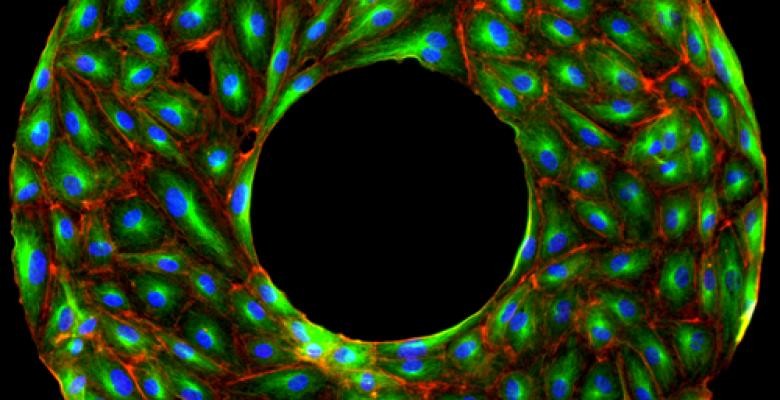Prof. Vunjak-Novakovic Develops New Approach to Study Stem Cell Function

A team of researchers led by Gordana Vunjak-Novakovic has developed a new technique to evaluate human stem cells using cell micropatterning — a simple but powerful in vitro tool that will enable scientists to study the initiation of left-right asymmetry during tissue formation, to diagnose disease, and to study factors that could lead to certain birth defects.
The study, led by Vunjak-Novakovic, Professor of Biomedical Engineering at Columbia University’s Fu Foundation School of Engineering and Applied Science, will be published in the online Early Editionof the Proceedings of the National Academy of Sciences the week of June 27, 2011.
Vunjak-Novakovic and her team have long been interested in developing technologies to investigate developmental processes of cells. In 2008 Leo Wan, a postdoctoral scientist from her lab, printed human cells onto microscopically small patterns to investigate the shape-force control of cell function; this study helped them learn more about the connections between mechanical tension generated inside the cell and the decisions that cells make.
As they looked into the numerous videos they made to document and analyze the shapes of cells on micropatterns over time in culture, they noticed that the cell populations on micropatterns had a life of their own. These small communities of cells would undergo directional motion and form chiral alignment after a day or two of culture, with all cells moving in the same direction within the boundaries. Vunjak-Novakovic said “It was really the consistency of this motion pattern – the same cell type would always take the same direction with extremely high statistical power – that was intriguing and made us do hundreds of experiments.”
They found that the direction of motion depended on cell type — that normal cells and cancer cells of the same type show opposite direction of motion, and that the mechanism by which the directional motion is established involves the actin stress fibers inside the cell. “What’s really interesting about this work is that it shows that cells can establish a consistently biased asymmetry without the help of large-scale embryonic structures,” said Vunjak-Novakovic. “Our study clearly demonstrated that mammalian cells could establish and organize consistent asymmetry without cilia or node, a finding of great interest to those of us in cell and both developmental biology and stem cell bioengineering. The use of cell patterning techniques for studying cell asymmetry, or chirality, is entirely novel, and it enables obtaining a lot of biological and medical information by analyzing cell motion on tiny patterns.”
Vunjak-Novakovic and her team plan to extend their research in several directions, by working:
- with developmental biologists to get deeper insights into the establishment of left-right asymmetry
- with cancer biologists to evaluate the capacity of this technology to diagnose disease
- in cardiac tissue engineering to pattern signal propagation in cell populations.
“We are very excited about developing this technology that gives us insights into the small world of the cells, in a way that is predictive of their behavior in the whole organism,” added Vunjak-Novakovic. “But what’s also really striking are the images of cells on micropatterns — these are the most beautiful hybrids of art and science I have ever seen!’
Columbia has filed a patent application covering potential commercial applications of the discovery and, through its technology transfer office, Columbia Technology Ventures, is seeking partners to develop these applications.
Vunjak-Novakovic’s study was supported by the National Institutes of Health (NIH) and the National Institute of Biomedical Imaging and Bioengineering (NIBIB), through a Tissue Engineering Resource Center grant.